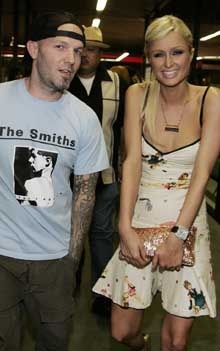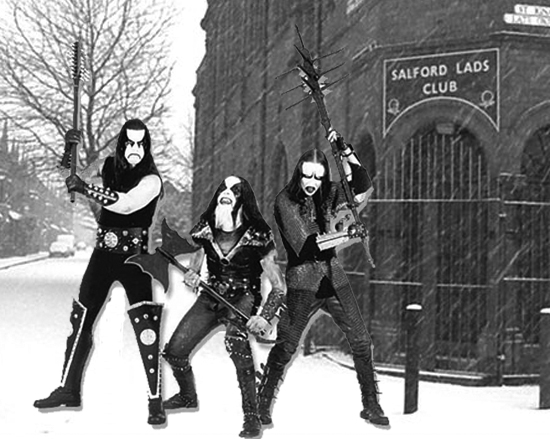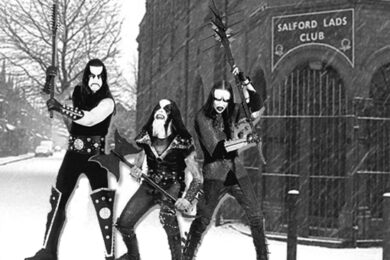Without wanting to come across too much like one of those guff-spouting wazzocks off I ♥ 1983, that particular year arguably saw the peak of divisiveness and tribalism in UK youth culture. The make of T-shirt you wore, the haircut you sported and even the type of footwear you favoured was either the membership to a quite exclusive club or an invitation to at best derision, at worst a good hiding. This country had never seen so much diversity in its musical loyalties and never would again. Despite already being dead in the water in terms of creativity, punk’s mohican shadow loomed still large. As well as relative newcomers goth and psychobilly there was the intransigent, ugly and thuggish offspring of the blue note boys: skinheads. Elsewhere electro, hip hop, two-tone, soul, synth pop, new romantic and pop all had their own dress codes and modes of behaviour. But enjoying a huge flush of popularity off the back of the NWOBHM bands such as Iron Maiden and Judas Priest, was heavy metal.
One thing that was very interesting about the time was how, finally, feminist thinking of the sixties and seventies was
starting to cascade down into the steadfastly male dominated arena of rock music. Punk and post punk bands such as Siouxsie and the Banshees and The Slits continued to stick two fingers up at the objectification of women but for some even punk was no good; expecting, as it often did, women to behave like men, favouring boorish violence at gigs and a relatively macho attitude. For the most part rock’s attitude towards women was institutionally misogynistic: stay away from gigs which feature rock music for men and stick to the discos where they play pop music for girls. Never was this attitude more apparent than in the closed society of heavy metal, where the credo appeared to be: hanging out with girls? That’s for poofs.
But the feminisation, not just of rock, but the entirety of popular music’s canon was underway and it was proving to be unstoppable. It’s just that it would take much longer for it to even dent metal’s armour.
It was into this dayglo mix that The Smiths were born. Morrissey became almost overnight a beacon to the disaffected and alienated. He was a construct of contradictions: resolutely working class yet a foppish aesthete; there was, in the vernacular of the day, a whiff of lavender about him, yet he came across like a 50s matinee idol; his lyrics protested a shyness that was “criminally vulgar”, yet he can easily be pinned down as one of the most arrogant and self-assured frontmen this country has ever produced. He pioneered a new and subtle form of dangerousness: no one could fully explain what he was or what he stood for.
So The Smiths represented the heart-quickening excitement of danger – but not one of brute violence at gigs, but one of ideas. Both women and men who felt disenfranchised by other scenes, suddenly felt represented by this odd figure, this gangly mix of Oscar Wilde, James Dean and John Lydon. His refusal to give straight answers about his sexuality signposted a time (still yet to come) where people didn’t need to be straitjacketed by their orientation. His everyday flamboyance appealed to those with a less theatrical bent than the goths or new romantics. In times of such fierce youth tribalism, Moz was the figurehead for people who wanted to be truly individual. Movements such as punk and goth may have been started by people who wanted to express their individuality but it was not long after the inception of each scene, that the uniform and code of conduct became set in stone. (This is not to say that the charity shop individualism of The Smiths hadn’t become a fashion statement itself by the time the group split. Check the video to ‘Stop Me If You Think You’ve Heard This One Before’.)
Metal and The Smiths did not see eye to eye though. There was no
overlap between the two circles on this particular Venn Diagram. In fact the circles were miles apart and separated by a no man’s land covered in mines and razor wire. If some of The Smiths’ more morbid and literary interests were shared by the goths; if some of the bile at social injustice was shared with the punks; if the same love of sparkling hooks was shared by the pop mainstream; if some of the self-aware lyrical games were shared with new pop; nothing connected them to heavy metal (bar possibly the guitar solo to ‘Shoplifters Of The World Unite’). Leaving one question: if you fast-forward 25 years, how have The Smiths and Morrissey become cited as a key influence by a sizeable proportion of young metallers and rockers?
Put simply, rock has changed rather than Stephen Patrick.
At the Kerrang! end of the scale you can’t read an interview with Gerard Way from My Chemical Romance, Colin Doran from 100 Reasons or Matt Davies from Funeral For A Friend singing the praises of this none-more-grey Manchester band. You may dismiss this as just an emo fad, but that would be to ignore such unambiguously METAL statements as Sepultura covering ‘How Soon Is Now?’, ‘Vicar In A Tutu’ by Therapy?, ‘Bigmouth Strikes Again’ by Slapshot and ‘Girlfriend In A Coma’ by Million Dead.
Put simply, rock has changed rather than Steven Patrick. As much as fans of this genre like to believe it has remained as steady as an, erm, rock over the years, it is their music that has proved to be malleable. Whereas once gigs were mainly male affairs, strangely homoerotic events of naked male torsos, slick with sweat, beer and testosterone-fuelled camaraderie, the balance of power has shifted dramatically. Go to your average metal gig now and sometimes female punters can even outnumber males. Bands such as Iron Maiden, Venom and Motorhead dressed in a way that some aspirational blokes followed. It is undeniable that a sizeable minority of women may have loved this blend of outsider, Viking and biker chic but this was little other than an unintentional fringe benefit for the boys in the bands and the fans who looked like them.
The image of metal and heavy rock, thankfully, has been stage-managed to appeal to young women. Avenged Sevenfold haven’t got so buff to keep their male fans happy, Gerard Way isn’t wearing all that eye shadow to keep the boys coming to gigs, and so on and so forth. This feminisation (rather than the emasculation that some see it as) started snowballing with the surge in popularity of emo that happened about six years ago. This is probably one of the few tangible benefits to come out of this mass-movement of whingeing, fringe straightening, emotive fist clenching and lip piercing.
Metal had always been concerned with the confrontation of male angst and defining the individual through aggression and rebellion; the idea of the lone outsider being quite a masculine one. But the confessional element brought to the table by bands such as Thrice and Taking Back Sunday as well as industrial bands such as Nine Inch Nails helped to further unsettle this stereotype.
If it seems that we’re being too hard on old school metallers, then we don’t mean to be – these are the broadest of broad brush strokes. In the 70s and 80s working class men were the whipping boys of the media and the educated elite. It was no wonder that they wanted a gang that only they could be members of; that of the tight trousered, bullet belt wearing, beer swilling rock outlaw.
Seen from this position of splendid isolation, it is no wonder that they would be suspicious of what they viewed to be a university phenomenon (none of The Smiths had higher education of any sort but they were championed by the then ‘student bible’, NME). For the protective and insular rock community to accept Morrissey, he had to fall from grace with the London based media and the chattering classes they serviced – while he was still the favourite of exactly the sort of middle class tastemakers who continuously derided metal as being gauche and provincial, he was deemed to be persona non grata.
But after the split of The Smiths, when Morrissey started mining darker and darker lyrical concerns (or his pursuit of controversy took on a slightly hysterical and annoying edge) it soon became clear that this critical fall from grace wasn’t going to be that long in coming. After Madstock at Finsbury Park in 1992 it would be false to suggest that his career was in tatters but his popularity waned; his dedicated fan base could still be relied upon to buy concert tickets and albums but it genuinely felt like he was about to become a footnote in the history of music.

Of course there are other factors at play here. The way we consume music has changed so much because of MP3s and downloading that the fierce music-based youth tribalism seems vaguely ridiculous in 2009. As much as it might annoy the man himself, Viva Hate probably nestles up to "vile" reggae on many people’s iPods now.
As a youth himself, Morrissey was obsessed with rock culture being a long haired dole head, and, weirdly, was in a rock band with Billy Duffy before he formed goth/classicist rockers The Cult. This obsession ran so deep that the bequiffed one had a book on proto-punk glam rockers the New York Dolls published before he became a singer. So perhaps it is just a case of him traveling full circle by hiring producer Jerry Finn and keyboard player Roger Manning (both of whom have previously worked together with Blink 182) to work on Years Of Refusal.
So the differences are not really that great after all. When Gerard Way declares himself the “king of the faggots” he is, no matter clumsily, aping Morrissey’s complex attitude towards his sexuality (something he in turn, learned from stars such as David Bowie). It is fitting that the last clearly defined outsider youth tribe has finally taken to one of the last great iconic outsider figures of pop.



